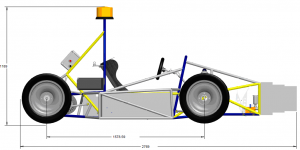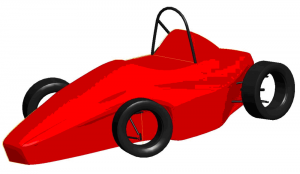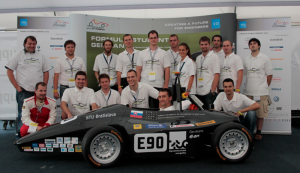Implementation of electric propulsion in small race car
20. September, 2010, Autor článku: Benkovský Peter, Elektrotechnika, Študentské práce
Ročník 3, číslo 9  Pridať príspevok
Pridať príspevok
 The paper deals with a new design method used in construction of pure electric vehicle based on the frame of the well-known Formula Student race car. The functional principles of the electric vehicles are first introduced. Then the main parts of the electric drive system are described. Optimal system components are proposed according to computed values of drive drags to meet required performance criteria. The whole concept of electric formula race car is verified by simulations in Matlab/Simulink computer code, where basic performance parameters of the electric formula are calculated.
The paper deals with a new design method used in construction of pure electric vehicle based on the frame of the well-known Formula Student race car. The functional principles of the electric vehicles are first introduced. Then the main parts of the electric drive system are described. Optimal system components are proposed according to computed values of drive drags to meet required performance criteria. The whole concept of electric formula race car is verified by simulations in Matlab/Simulink computer code, where basic performance parameters of the electric formula are calculated.
1 INTRODUCTION
Transportation is a primary source of energy consumption and pollutant emissions worldwide. With the stricter restrictions on air pollution and shortage of fossil fuels, the advantages of electric vehicles (EV) are becoming more evident than ever. The technology has now been accepted by more and more vehicle manufacturers and users. However, the design of electric vehicles is difficult due to the large amount of inter-relating design parameters and conflicting design objectives. Electric vehicles (EVs) use an electric motor for traction, and chemical batteries or other appliances for their corresponding energy sources. The electric vehicle has many advantages over the conventional internal combustion engine vehicle (ICEV), such as an absence of emissions, high efficiency, independence from petroleum, and quiet and smooth operation. The operational and fundamental principles in EVs and ICEVs are similar (Ehsani, et al., 2005).
These basic principles are the same for common vehicles and for race vehicles. Designing the race vehicle with electric propulsion is something special because other priorities and requirements must be considered. That means that the vehicle should have low weight and very good dynamic performance parameters. Maximum driving range is not that important. Race car has to be good in cornering, acceleration and braking. Electric drivetrain can fulfill these requirements, because of optimal torque characteristics of an electric motor. Actual advanced power sources, e.g. chemical batteries based on Lithium, are offering enough power to supply electric motors.
1.1 Formula Student race car description
Formula Student race car is a small single seat formula race car built according to specified rules by university students from all over the world. The idea of the project is to improve engineering design and business skills of students and to participate at racing competitions. The formula race car could be driven by internal combustion engine, by hybrid drive or by electric drive. Its chassis could be constructed like monocoque made of carbon fibres or like strut-frame welded from high-tensile steel tubes. All four wheels have independent suspension and disc brakes. Front wheels are used for steering and rear wheels are driven. In front of the vehicle is situated impact attenuator to increase passive safety. The bodywork is usually made of carbon laminate. The race car must show very good driving characteristics such as acceleration, braking and handling.
Examined vehicle has electric drive system and its chassis are made of steel tubes. It was designed by students of STU in Bratislava (see Fig. 1).
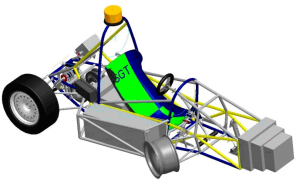
Fig. 1 Formula Student Electric race car chassis designed by Stuba Green Team Bratislava
2 PERFORMANCE PARAMETERS OF THE VEHICLE
There are several forces acting on a moving vehicle. The tractive effort in the contact area between tires of the driven wheels and the road surface propels the vehicle forward. It is produced by the power plant torque and is transferred through transmission and final drive to the drive wheels. While the vehicle is moving, there is resistance that tries to stop its movement. The resistance usually includes tire rolling resistance, aerodynamic drag, uphill resistance and forces of inertia (Ehsani, et al., 2005).
Motor vehicles use power of their powertrain system to get over tractive resistance. Power required on the drive wheels could be calculated by the sum of resistance power presented in this formula (Ferencey, et al., 2007):
| (1) |
Formula Student Electric race car was designed to meet sports requirements. That means that the race car should have maximum speed over 100 km/h and acceleration to this speed in 5 seconds. Important parameter is the vehicle mass, which affects the resistances. Maximum weight of the electric formula race car should not exceed 350 kg.
According to equation no.1, we were able to define dynamic requirements on tractive system, which are power, torque, max. rpm of the motors, etc. But to choose suitable components of the electric drive system, it is important to consider even more parameters, for example vehicle constraints, weight of the tractive system, electric current flow, type of power source (voltage) and last but not least the price of components. Defined requirements are power over 30 kW and torque about 70 Nm.
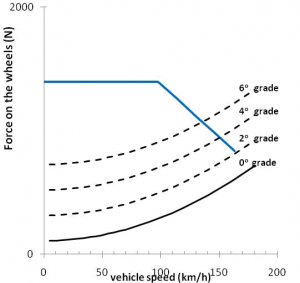
Fig. 2 Forces acting on formula race car (blue – tractive force, black – rolling resistance and aerodynamic drag, comma-shaped – uphill resistance)
3 TRACTIVE SYSTEM OF THE FORMULA RACE CAR
Main components of the electric tractive system are analyzed here. An automotive power train consists of a power plant (electric motors), energy source (batteries), transmission (final gear), differential (electronic differential), drive shaft and driven wheels.
Tractive system of the Formula Student Electric race car designed by Stuba Green Team consists of high voltage and low voltage part. The system operates at direct current – DC voltage, so there is no need to use inverters and converters.
Every circuit, which carries more than a nominal operation voltage of 60 V DC or 25 V AC RMS, is defined as part of the High Voltage system. High voltage part consists of three battery packs, six main contactors, two motor controllers and two electric motors. The Low Voltage part or the control system of the car is defined as every electrical part that is not part of the high voltage system.

Fig. 3 High voltage part of the tractive system
3.1 Electric motors
Electric motors are the heart of the tractive system. The electric motor converts the electric energy into mechanical energy to propel the vehicle, or, vice versa, to enable regenerative braking. We have chosen Brush-Less DC motors with permanent magnets from company L.M.C. Ltd. There are two BLDC motors LEM-200 type D135 installed in the formula race car to fulfil requirements defined above.
Tab. 1 Motor specification
| Motor | Rated Power [kW] | Rated Speed [Rpm] | Rated Voltage [V] | Rated Current [A] |
|---|---|---|---|---|
| D135 | 15 | 3780 | 84 | 200 |

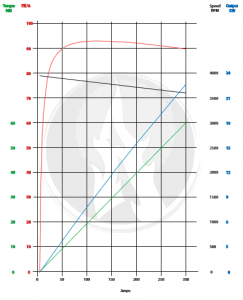
Fig. 4 BLDC motor LEM-200 type D135 and its characteristics
Each motor drives one wheel through chain drive train. This configuration requires use of a so-called electronic differential, which is software installed in the electronic control unit. Electronic differential perform a similar function as mechanical differential, but without mechanical parts, what saves weight. The electronic differential must take account of the speed difference between wheels when cornering (Hartani, et al., 2008). Electric motor on the inner side of the car operates with lower speed and motor on the outer side increases its speed to achieve smooth drive on curved roads. Electronic differential consists of two speed sensors on the wheels, sensor of the angle of the steering wheel and electronic control unit.
3.2 Accumulators
Electric accumulators used in the vehicle are electrochemical batteries which are energy storages defined as the devices that store energy, deliver energy outside (discharge), and accept energy from outside (charge).
There are a number of requirements for energy storage applied in an automotive application, such as specific energy, specific power, efficiency, maintenance requirement, management, cost, environmental adaptation and friendliness, and safety.
They were all considered and we have chosen batteries from company named Thunder-Sky. Their chemical type is LiFeYPO4 and the model is TS-LFP100AHA. Stuba Green Team uses 28 of them to supply their Formula Student Electric race car with electric energy. The used battery stacks are enclosed in three battery containers to ensure good weight distribution of the car.
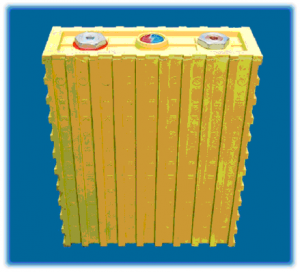
Fig. 5 Battery cell TS-LFP100AHA.
Tab. 2 Battery cell specification
| Battery model | Nominal Capacity [Ah] | Operating voltage [V] | Weight [kg] | Operating temperature [oC] |
|---|---|---|---|---|
| TS | 100 | 2.5-4.25 | 3.2 | - 20~75 |
3.3 Controllers
The electronic controller commands the tractive system by providing control signals to it, and then controls the operation of the electric motor to produce proper torque and speed, according to the command from the drive. The electronic controller can be further divided into three functional units — sensor, interface circuitry, and processor. The sensor is used to translate measurable quantities such as current, voltage, temperature, speed, torque, and flux into electric signals through the interface circuitry. These signals are conditioned to the appropriate level before being fed into the processor. Control system has operation voltage of 12 V DC. The tractive system sensor set consists of position sensors on the throttle and brake pedals, steering wheel angle sensor, wheel and vehicle speed sensors, temperature sensors and battery management system. The control system must be grounded to the chassis.
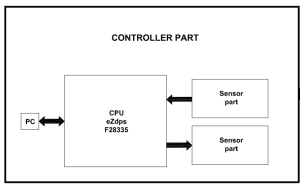
Fig. 6 Scheme of the controller part
3.4 Safety requirements
Electricity is sometimes dangerous for human health, so electrical safety is very important. Formula Student Electric race car must comply with specified safety rules of the competition. The vehicle undergoes series of technical inspection during the racing event. That is why the safety is the principal issue in designing tractive system.
The tractive system must be completely insulated from the chassis or any other conductive parts of the car. The high voltage part and control system must be completely galvanically separated. All parts of the tractive system are isolated by nonconductive material. The formula race car must have an insulation monitoring device installed in the tractive system. The car is equipped with a tractive-system-active light. A system of three shut-down buttons must be installed in the vehicle as presented by the figure 7.
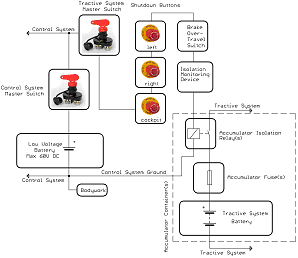
Fig. 7 Schematic overview of the car’s shutdown system
Each accumulator must be monitored by a battery management system (BMS). The BMS measures the cell voltage and temperature of every cell to keep the cell inside the allowed voltage and temperature range during charging and discharging. Every accumulator container contains one fuse and one accumulator insulation relay (see Fig. 7). High voltage parts of the tractive system must be orange in colour and marked with High Voltage Sticker (FSE Rules, 2010).
4 DRIVING SIMULATIONS
Illustrative driving simulation example is provided to support the theoretical results derived in the previous section. The whole concept of electric formula race car is verified by driving simulation in Matlab/Simulink computer code (see Fig. 10). Simulation shows acceleration to speed 95 km/h, which was achieved within 4 seconds, and then drive with constant speed of 90 km/h, where electric current flow during discharge of batteries of the electric formula is examined (see Fig. 9). Maximal discharge current during acceleration is about 590 A, because of large resistance caused by forces of inertia. During drive at constant speed the driving resistance is much lower and the discharge current drawn from batteries to supply motors is much lower and is about 70 A.

Fig. 8 Vehicle speed simulation

Fig. 9 Electric current flow during discharge of batteries
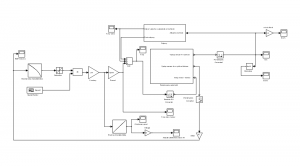
Fig. 10 Simulation scheme of the formula race car tractive system in Simulink
5 CONCLUSION
In the field of Formula Student race cars, an application of electric propulsion is presented. The paper proposes implementation of electric tractive system with two electric BLDC motors working as electronic differential, which are supplied by series of 28 lithium battery cells placed in three containers. Obtained results from simulations were essential to verify feasibility of proposed electric tractive system. The contribution of this work is to present that there are people who are able to design electric vehicles in Slovakia.
REFERENCES
- Ehsani, M., Y. Gao, S.E. Gay and A.Emadi, (2005). Modern Electric, Hybrid Electric, and Fuel Cell Vehicles CRC Press, Boca Raton, Florida,ISBN: 0-8493-3154-4
- Ferencey, V. and Kováčová, M. (2007). Projektovanie motorových vozidiel, Slovenská technická univerzita v Bratislave, ISBN : 978-80-89313-05-1
- Hartani, K., Bourahla, M., Miloud, Y., (2008). Direct Torque Control of an Electronic Differential for Electric Vehicle with Separate Wheel Drives, In: J. Automation & Systems Engineering, regular conference paper, .pdf file, Algeria
- Formula Student Electric Rules 2010, Germany http://www.formulastudentelectric.de/uploads/media/FSE_Rules_2010_v1.5.0.pdf
ACKNOWLEDGEMENT
This paper would not be written if the Formula Student Electric project would not be solved at STU in Bratislava by the group of students who call themselves Stuba Green Team. Their work would be useless without support of companies, who became sponsors of the project. Authors of the paper would like to thank to those companies and to other team-members for their support.
Annex :
Peter Benkovský, Slovak University of Technology, Faculty of Mechanical Engineering, Department of applied mechanics and mechatronics, Námestie slobody 17, 81231 Bratislava, peter.benkovsky@stuba.sk
Vladimír Staňák, Slovak University of Technology, Faculty of Electrical Engineering and Information Technology, Department of mechanics, Ilkovičova 3, 81219 Bratislava, vladimir.stanak@stuba.sk
